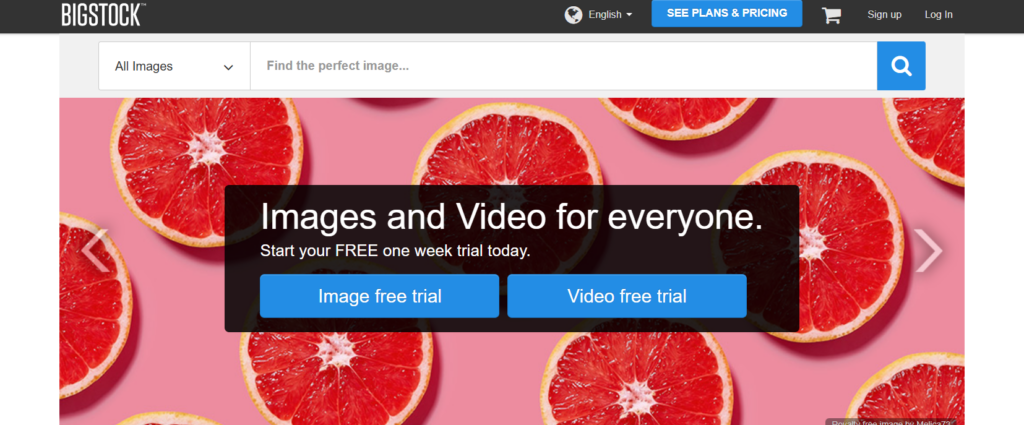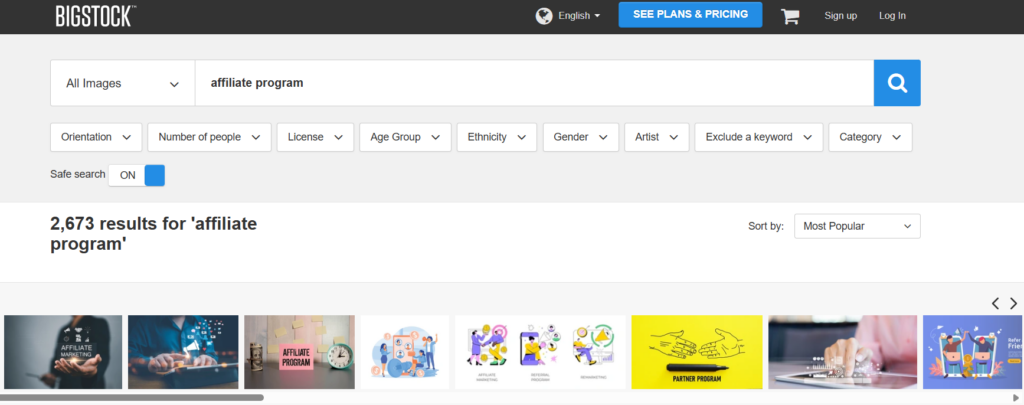Bigstockphoto.com, commonly referred to as Bigstock, is a prominent international microstock photography platform offering royalty-free images, vectors, illustrations, and videos. Founded in 2004 in Davis, California, Bigstock quickly established itself as a reliable marketplace for affordable stock imagery. In 2009, it was acquired by Shutterstock, one of the leading providers of digital imagery licensing worldwide. As of recent years, Bigstock has ceased accepting new content submissions and is transitioning due to Shutterstock’s merger with Getty Images.

Key Features
Extensive Image Library
- Bigstock boasts a massive catalog with over 22 million royalty-free assets, including photos, vectors, illustrations, and videos.
Flexible Pricing Options
- Offers credit-based pricing plans and subscriptions that cater to various budgets. Images can cost as little as $0.16 per download with subscription plans or up to $21 for individual purchases.
Royalty-Free Licensing
- All content is royalty-free, meaning users can safely use assets for both personal and commercial projects without additional licensing fees.
Ease of Use
- The platform provides a user-friendly interface with keyword search functionality and categorized browsing options. Popular categories include business, nature, food, health, and more.
Global Accessibility
- Designed for international users, the website supports 20 languages and offers localized features for global accessibility.
Free Trial
- New users can access a 7-day free trial that includes up to 35 downloads of stock images or videos5.
Customer Support
- Bigstock is known for its responsive customer service via phone, email, and online chat.
Benefits of Using Bigstock
- Affordability: Bigstock provides competitive pricing compared to other stock photo platforms. Its subscription plans allow users to download assets at minimal costs per image or video.
- Variety: The platform offers diverse content types—photos, illustrations, vectors, and videos—making it ideal for designers and businesses with varied project needs.
- Quality Assurance: All assets are high-quality and technically sound, ensuring professional results for users’ projects.
- Flexible Downloads: Users can select image sizes based on their needs (e.g., thumbnails or high-resolution files), optimizing costs for specific projects.
- Accessibility Features: The multilingual interface ensures seamless navigation for users worldwide.
- Satisfaction Guarantee: Bigstock offers refunds on subscriptions if users are dissatisfied with the service.
- Free Resources: Monthly free images and trial periods make the platform accessible to new users without upfront commitments.
Historical Insights
Bigstock was initially developed as a competitor to iStock by visionary entrepreneur Tim Donahue in collaboration with RexSoft. Within a year of its launch in 2005, it gained recognition from PayPal as one of the most developed projects in the U.S. market. Its acquisition by Shutterstock in 2009 further solidified its position in the stock photography industry.
Current Status
While Bigstock remains operational as part of Shutterstock’s portfolio, it no longer accepts new content submissions, effective July 2023. The service continues to serve designers and businesses globally but is changing due to Shutterstock’s merger with Getty Images in early 2025.
Check out Bonfire to create and sell custom apparel online with zero upfront costs—perfect for creators, fundraisers, and small businesses.
How does Bigstock’s credit-based system work?
Bigstock’s credit-based purchasing system is designed to offer flexibility and affordability for users who need occasional access to stock images without committing to a subscription plan. Here’s how it works:
Overview of the Credit-Based System
- Credits as Currency: Bigstock uses credits as its internal currency for purchasing images. Users buy credit packs, which can then be used to download images based on their resolution and size.
- Image Pricing by Size: Images are priced from 1 credit for small sizes to up to 6 credits for extra-large sizes. This tiered pricing ensures that users pay only for the resolution they need.
Credit Pack Options
Bigstock offers several credit pack sizes, with discounts increasing as the pack size grows:
- 10 Credits: $35 ($3.50 per credit)
- 25 Credits: $49 ($1.96 per credit)
- 100 Credits: $169 ($1.69 per credit)
- 250 Credits: $339 ($1.36 per credit)
- 500 Credits: $495 ($0.99 per credit).
Credits are valid for 12 months from the date of purchase, allowing users to download images at their convenience without time pressure.
Benefits of the Credit-Based System
- Flexibility: Ideal for occasional buyers who don’t require large volumes of stock images regularly.
- Cost Efficiency: Larger credit packs offer significant savings, reducing the cost per image.
- No Subscription Commitment: Users can purchase credits as needed without subscribing to monthly or daily plans.
- Customizable Downloads: Users can select image resolutions based on project requirements, optimizing costs.
Comparison with Other Payment Models
While Bigstock also offers subscription plans and a Pay-As-You-Go option (starting at $2.99 per image), the credit system provides an intermediate solution between these two extremes:
- Subscriptions are ideal for high-volume users who need consistent access.
- Pay-As-You-Go works best for single-image purchases.
- The credit system balances affordability and flexibility, particularly for medium-volume users.
Limitations
Although the credit system is cost-effective, higher-resolution images require more credits (up to 6), which can make individual downloads expensive compared to subscription plans. Additionally, credits expire after a year, so unused credits must be utilized within that timeframe.
In conclusion, Bigstock’s credit-based system is a versatile option tailored to occasional buyers seeking flexibility and affordability without committing to long-term plans. It complements other payment models offered by Bigstock, catering to a wide range of user needs.
What types of images are most popular on Bigstock?
The most popular types of images on Bigstock reflect the diverse needs of its user base, including designers, marketers, and businesses. Here are the categories that stand out:

Popular Image Categories
- Business and Corporate:
- Images depicting office environments, teamwork, and professional settings are widely used for presentations, websites, and marketing materials.
- Nature and Landscapes:
- Scenic photos of mountains, forests, beaches, and other natural elements are frequently chosen for creative projects and advertisements.
- Food and Beverages:
- High-quality images of meals, ingredients, and drinks are popular among bloggers, restaurants, and food-related businesses.
- Health and Wellness:
- Photos related to fitness, healthcare, and mental well-being are commonly used in campaigns for health services or lifestyle brands.
- People:
- Portraits and candid shots of diverse individuals in various activities are often used for marketing campaigns to represent inclusivity and relatability.
- Animals:
- Images of pets or wildlife are popular for personal projects or niche marketing.
- Objects and Technology:
- Photos of gadgets, tools, and everyday objects are favored by tech companies and product designers.
- Sports and Activities:
- Action shots of athletes or outdoor activities cater to fitness brands and event promotions.
Why These Categories Are Popular
- Versatility: These themes align with common design needs across industries.
- High Demand: Businesses often require images in these categories for branding, advertising, social media posts, and content creation.
- Quality: Bigstock ensures high-resolution images that meet professional standards.
The platform’s advanced search engine makes it easy to locate specific types of images within these popular categories by keywords or filters.
Discover MyFonts for a vast collection of premium fonts and tools to buy, sell, and explore unique typography for any creative project.
Why did Bigstock stop accepting new content submissions?
Bigstock stopped accepting new content submissions as of July 1, 2023, primarily due to its parent company Shutterstock’s strategic shifts and ongoing merger with Getty Images. Here are some key factors contributing to this decision:
- Shutterstock’s Strategic Focus: Shutterstock, which acquired Bigstock in 2009, has been focusing on integrating its services and expanding its offerings. The decision to halt new submissions at Bigstock aligns with this broader strategy, possibly to consolidate resources and streamline operations across its platforms.
- Merger with Getty Images: The merger between Shutterstock and Getty Images is a significant factor. This integration likely involves reorganizing and optimizing their combined content offerings, which may include reducing the number of platforms accepting new submissions to maintain quality and efficiency.
- Industry Trends and AI Integration: The stock photography industry is evolving, with many platforms leveraging AI for image generation and training. This shift might influence how companies manage their content libraries, potentially leading to a focus on existing collections rather than expanding them.
- Operational Efficiency: By not accepting new submissions, Bigstock can focus on maintaining and optimizing its existing library, ensuring that it remains relevant and competitive in the market without the need for continuous content expansion.
Overall, the decision reflects a strategic realignment within the industry, driven by technological advancements and market consolidation.
Bigstockphoto Partnered or Affiliated Program

Bigstock offers an Affiliated Program that allows users to earn commissions by promoting Bigstock’s services. However, specific details about the program’s structure and benefits are not widely available. Generally, affiliate programs in similar industries offer commissions for referrals, provide marketing materials, and track earnings through a dashboard. For more detailed information, you may need to contact Bigstock directly or explore affiliate networks, such as FlexOffers, which manage these programs.




